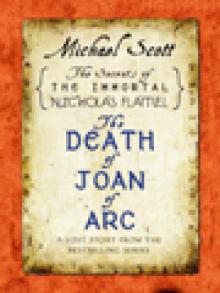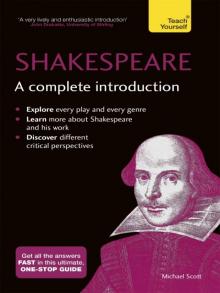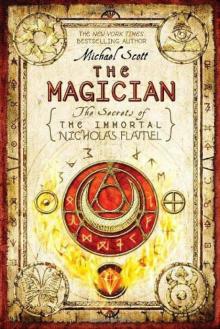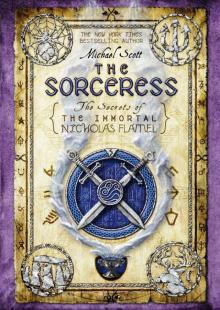- Home
- Michael Scott
Shakespeare- a Complete Introduction Page 4
Shakespeare- a Complete Introduction Read online
Page 4
Today we recognize that Samuel Johnson is judging the plays by the social attitudes and ideologies of his own age. Despite his rejection of the Aristotelian Unities, he remains bound within the neoclassical tradition, with eighteenth-century notions of decorum and the mindset that accompanies them. Such an eighteenth-century taste for decorum and elegance did not sit easily with what then might have been considered the crudity of Shakespeare’s frequent use of the pun. Today, however, modern criticism appreciates the pun’s social and political subversive nature – as noted, for example, by Peter Davison:
‘The pun – and again, the bad pun especially – as used by Shakespeare, plays not only upon the word but upon the individual’s relationship with the community, within the play-world and the real-world. It epitomizes both our individuality and, through the response, that we have a place in the community. Of all literary devices it is the one that, in a hierarchical community, can most readily transcend class…The bad pun may be said to be the epitome of “popular appeal”, demanding of an audience to a play conscious awareness of, and response to, extra-dramatic, social, relationships.’
Davison, P. [1982: 78], Popular Appeal in English Drama to 1850. Basingstoke: Macmillan
If the pun caused Dr Johnson unease, so too the ending of King Lear undermined his sense of decorum and violated his eighteenth-century commitment to a kind of poetic justice:
‘…if my sensations could add anything to the general suffrage, I might relate that I was many years ago so shocked by Cordelia’s death, that I know not whether I ever endured to read again the last scenes of the play till I undertook to revise them as editor.’
Johnson, Dr S., in Woudhuysen, H.R. (ed.) (1989: 222–3), Samuel Johnson on Shakespeare. Harmondsworth: New Penguin Shakespeare Library
Nahum Tate’s 1681 adaptation accorded with natural justice until a revival of something like the original version of King Lear in the early nineteenth century, when in 1823 the actor Edmund Kean and later in 1838 Charles Macready moved performances away from Tate’s happy ending and gradually reinstated the ending of Shakespeare’s tragedy with which we are familiar today, and of which Charles Dickens approved.
The late 1780s proved a great turning point in the history of the Western world with the American War of Independence in 1787 and the French Revolution in 1789. It was perhaps as seismic a shift in cultural and social perceptions as was the European Reformation and Henry VIII’s revolt against Rome in the sixteenth century, both of which had such a profound effect in Shakespeare’s lifetime. The French Revolution was not only a political but an intellectual movement, which had an effect on the emergence of the European Enlightenment and Romanticism at the end of the eighteenth and the beginning of the nineteenth centuries, and which paved the way in turn to the growth of realism as the nineteenth century progressed.
Romanticism
The Romantic Movement fundamentally changed attitudes towards Shakespeare. English Romantic critics and poets and writers and poets in Germany regarded poetic expression as the pinnacle of philosophy. If Shakespeare were the supreme poet, then he was to be venerated as the greatest of all thinkers, paving the way for ‘bardolatry’ to take hold.
Hector Berlioz (1803–69), an intensely romantic composer who composed the wildly macabre Symphonie fantastique and works based on Shakespeare’s plays, regarded him as ‘the living and loving God’:
‘Shakespeare! You were a man. You, if you still exist, must be a refuge for the wretched. It is you that are our father, our father in heaven, if there is a heaven…Thou alone for the souls of artists are the living and loving God. Receive us, father, into thy bosom, guard us, save us! De profundis ad te clamo. What are death and nothingness? Genius is immortal!’
Berlioz, H.; see Bate, J. (1989: 247), Shakespeare and the English Romantic Imagination. Oxford: Clarendon Press
In England, the influential Romantic poet Samuel Taylor Coleridge (1772–1834) concentrated attention on language and the characters that spoke it. The question of genius was resolved through an understanding of language and character as the fundamental components of the plays.
Coleridge developed the notion from German philosophy of the organic form of the play as opposed to the mechanical and rustic forms identified by earlier criticism. A. W. Von Schlegel (1769–1845) between 1808 and 1811 had challenged the rules that neoclassicism had imposed upon plays. In his view, it was this imposition that had produced a lifeless garden of artificial flowers, but for him true art had to be organic. Art changes from principles within itself; it is innate and unfolds like a flower according to its own organic nature. The consequence is that you don’t criticize one flower because it is not like another one. You appreciate it for itself, for its own innate nature.
‘Form is mechanical when, through external force, it is imparted to any material merely as an accidental addition without reference to its quality…Organical form…unfolds itself from within, and acquires its determination contemporaneously with the perfect development of the germ. We everywhere discover such forms in nature…In the fine arts, as well as in the domain of nature – the supreme artist – all genuine forms are organical, that is, determined by the quality of the work.’
Schlegel, A. W. von; see Bate, J. (1989: 12–13), Shakespeare and the English Romantic Imagination. Oxford: Clarendon Press
Applied to Shakespeare or other great poets, this approach insisted that the artist might not be aware of the organic laws governing the unfolding of the work of art, since it is a combination of the unconscious and the conscious mind in cooperation that creates the poem or the play.
‘…the poet, in his dreams, institutes, as it were, experiments which are received with as much authority as if they had been made on waking objects.’
Schlegel, A. W. von; see Bate, J. (1992: 97), The Romantics on Shakespeare. Harmondsworth: Penguin Books
The primacy of language
The Romantics held that the uniqueness that informs everything emerges from the creative process. Language is thus regarded as the living principle of the play rather than the coat with which its thought is clothed. The play grows out of the words and thus, to understand the play, you need primarily to appreciate the language. Language, metre, poetry are a tripartite living principle. To understand the organic nature of the plays, you must first savour their language. As the twentieth-century critic L. C. Knights was to argue, the better the language the better the play. It is the language, the poetry that is paramount and continues to this day to be seen by many distinguished Shakespearean scholars and directors as the primary element of Shakespearean drama.
‘[Shakespeare] creates people, talking really, within a poem. There is poetry in structure, in juxtaposition, in rhythm. A poem is communication through image – and it is an ambiguous communication at that. Each individual image defies analysis, and together they add up, not to a thesis but to an experience. The ambiguity is intentional. The less it is explained by decor and costume, the greater is its richness. Whatever else we attempted or achieved in the production…everything – rehearsals, staging, performance – was aimed at communicating its poetry. Not just the spoken word, but the real poetry of the whole. The golden armour of the French…the follow spots…canopies…music, the empty stage, the actors’ changing styles and utterances, all were images within the overall poem.’
Terry Hands, former artistic director of the Royal Shakespeare Company, quoted in Beauman, S. (ed.) (1976: 26–7), The Royal Shakesepare Company’s Production of Henry V for the Centenary Season at the Royal Shakespeare Theatre. Oxford: Pergamon
Further, as the plays are composed of elements, the critic must search for the organizing principle of the play from within. For nineteenth-century commentators, influenced by developments in the novel as a literary form, this was located not in the plot but in ‘character’.
Organic growth, language and character, the determining features of the emerging novel form, become, through Romanticism, the dominant criteria of l
iterary criticism for the nineteenth and early twentieth centuries. Characterization starts to be seen as the determining force of the drama. Beginning with Maurice Morgann’s 1777 Essay on the Dramatic Character of Sir John Falstaff and developed in William Hazlitt’s Characters of Shakespeare’s Plays (1817), attention was focused on close textual analysis of what characters say of themselves as individuals whose lives extend beyond the actions in which they are involved. It is almost as if the characters are real people, and judgements are made about them as organic individuals. It was a critical trend which developed into the twentieth century with the appearance in 1904 of A. C. Bradley’s Shakespearean Tragedy, but which still retains a certain respectability. It is an approach, as we will see later, that began to be challenged in the 1930s, but which has also been challenged vigorously by more recent twentieth- and twenty-first-century criticism.
4
A Midsummer Night’s Dream (1595–6) and Romeo and Juliet (1595–6)
The dream is a complex theatrical metaphor. It is the double vision that allows us to watch, listen, consider and reflect – but rarely, if ever in comedy, to apportion blame. In this chapter we will consider two plays: A Midsummer Night’s Dream and Romeo and Juliet, written at almost the same time (1595–6). These can be seen as mirror images of each other, working from a similar structural foundation to produce in the one, comedy, using the dream metaphor, and in the other, tragedy, with reference to a particular dream. But the concept of dream itself is multi-layered, since plays in the theatre are also often described as dreams or fantasies. In these two plays metaphors accumulate, thereby opening to question and constantly challenging the audience’s perception.
A Midsummer Night’s Dream
You might ask what kind of dream it is that Shakespeare creates in A Midsummer Night’s Dream. Whose dream is it? How does he create it?
Let us take the second question first. As we have seen, Shakespeare elaborates on a basic formula that he develops for his drama. In this romantic comedy it begins with a problem, a serious threat, even of death. A geographical relocation or the taking on of a disguise then occurs until an awakening happens – a discovery – which brings about reconciliation and, in comedy, the resolution of the initial problem and the neutralization of the threat of death.
This is the structure underlying A Midsummer Night’s Dream which holds the play together. In The Comedy of Errors Shakespeare had two pairs of identical twins, whose escapades generate the hilarity of mistaken identities. In A Midsummer Night’s Dream he takes two couples, Lysander and Hermia and Demetrius and Helena, who enter a forest. It is a ‘wood’, which is a word that also meant ‘mad’ in Elizabethan colloquial speech. Here they become embroiled in a fairy world in which a third couple, Oberon, King of the Fairies, and Titania, Queen of the Fairies, are quarrelling over the ownership of a ‘changeling boy’. In fairy stories ‘a changeling’ is a child that has been exchanged for another at birth – a child that is of wronged or mistaken identity.
In this play Lysander and Hermia have fled to the forest from the Athenian court because Hermia wishes to marry Lysander, but her father Egeus (representing old age), wants her to marry Demetrius. The Duke (representing authority) rules in favour of the father and threatens the choice of death or the cloistered life of nun for Hermia if she does not obey. So the flight of the lovers is to escape the threats of age and parental authority. They wish to be free in their choice of partner and to establish an identity for themselves. Helena tells Demetrius, whom she loves but who does not love her, about the flight of Hermia and Lysander, thinking that the knowledge will make him love her. It does not, and he pursues Hermia and Lysander into the forest and Helena, in turn, pursues him. In going to the forest, unwittingly they are entering a ‘mad’ fairy world at odds with itself because of the quarrel between Oberon and Titania.
The King and Queen of the Fairies correspond to Theseus, the Duke of Athens, and his bride-to-be, Hippolyta, the Amazonian Queen. Indeed, both have past connections with Oberon and Titania in the fairy world. The audience sees in one set of characters a reflection of another set; in this case Oberon and Titania are reflections of Theseus and Hippolyta and vice versa, through what is known as correspondence. One set of characters corresponds to another set.
‘…the power of suggestion is the strength of the double plot, once you take two parts to correspond, any character may take on mana (an expression of an unseen force), because he seems to cause what he corresponds to or be Logos (the resulting word), of what he symbolizes.’
Empson, W. (1935: 34), Some Versions of Pastoral. New York: New Directions
(For more about mana and logos, see the key terms at the end of this chapter.)
THE SEARCH FOR THE SELF AND THE SELF’S LOVE FOR ANOTHER SELF
In some old medieval stories – such as the one recounted by Chaucer in The Wife of Bath’s Tale – the question arises of what a woman wants to be. The answer is to be herself, like any man. So the lovers flee to the forest to be or to find themselves. But what is that self, what is self-identity? What is the difference between being in love and being infatuated or self-deluded or merely self-gratifying? How do you find your own identity and reality? In this play, despite the opening threat of death, the search is for identity, for the self and the self’s love for another self, and they are portrayed through comic mistakes of identity and excursions into ‘madness’ brought about by Oberon and his mischievous attendant fairy, Puck.
We know from the start, of course, that this is a comedy and that all will, ultimately, be resolved happily. Compare this with Romeo and Juliet, written probably in the same period. Here Shakespeare changes the genre from the comic to the tragic within the play. Romeo, at first, is in love with Rosaline but his love changes from his own fancy almost as swiftly as Lysander’s changes in A Midsummer Night’s Dream under the influence of Oberon’s magic potion that is wrongly applied by Puck. Romeo gives up Rosaline for Juliet, even though we know that both the houses of Montague and Capulet are involved in a long-standing feud. His friend Mercutio tells him that being in love is being enslaved by the Fairy Queen, Mab, and soon after this the potentially romantic story turns sour. At the midpoint of the play, Mercutio, the cousin of the Prince, is killed in a fight with Juliet’s cousin, Tybalt, leading Romeo in the heat of the moment to avenge his friend’s death by killing Tybalt. Although the Prologue to the play has informed us from the start that the play will show that the lovers will take their own lives, it is at the point of Mercutio’s death (3.1.75f.) that the play moves into the tragic mode. The Queen Mab dream turns into a nightmare, with Mercutio’s death leading eventually to the tragic deaths of Romeo and Juliet.
In A Midsummer Night’s Dream there is a blurring between dreaming and waking, between the ‘dream’ and ‘reality’, but in Romeo and Juliet the opposition is ultimately between life and death. In both cases, but in different registers, the stage imitates issues of uncertainty that pervade existence. While I was writing this chapter, my three-year-old granddaughter, playing with her toys and lost in a fantasy world, suddenly stopped and asked, ‘I am real, aren’t I? I’m not pretend?’ She was told that she was not pretend and went happily back into the imaginative fantasy world in which she was playing.
Key idea
In A Midsummer Night’s Dream the question ‘I am real, aren’t I?’ is being asked by some of the characters as they eventually awake from their dream. What is it to be awake or asleep, to be real or pretend? How does a child, a lover, know what is real, know what love actually is? What is it to be oneself? This is not a problem for aristocrats alone or one for the learned. It is a question for everyone, whatever their station in society as they start to define their individuality through that society.
Identity and the individual
As we will see later in our discussion on tragedy, the concept of the individual as defined by the society in which he or she lives was beginning to be understood at the time of the Renaissance and Reforma
tion. As England, Wales, Scotland and Ireland as geographical locations were becoming important in the formation of a sense of national identity, traditional religious explanations concerning truth and authority, society and the individual were being questioned. With the growth of Protestantism and the challenge to the authority of the Catholic Church, the concept of a secular individualism was developing in an increasingly commercial society that was on the cusp of developing into what we now recognize as capitalist.
THE DREAM METAPHOR
The dream metaphor in A Midsummer Night’s Dream is used to generate the humour of the mistakes that are made. The love potion placed on the wrong lover’s eyes by the fairy, Puck; the punishment meted out to the Fairy Queen, Titania, for not doing as the Fairy King wants; the translation of Bottom, the weaver, into an ass with whom Titania falls in love: all these events border on cruelty and the grotesque but are rescued for comedy by a certain distancing of the action. The characters affected by the potions administered to them by Puck are in a dream, but we as an audience are both self-conscious and at the same time open to the prospect of being bewitched as we enter into the play’s bewitched narrative. We are watching a dream by being in the theatre, but we are also drawn into it.
‘The whole night’s action is presented as a release of shaping fantasy which brings clarification about the tricks of strong imagination. We watch a dream; but we are awake, thanks to pervasive humour about the tendency to take fantasy literally, whether in love, in superstition, or in Bottom’s mechanical dramatics.’

 The Warlock
The Warlock The Necromancer
The Necromancer Tom Cringle's Log
Tom Cringle's Log Delphi
Delphi The Magician
The Magician La mort de Jeanne d'Arc (trad. privee)
La mort de Jeanne d'Arc (trad. privee) Magic and Myth
Magic and Myth The Death of Joan of Arc
The Death of Joan of Arc Saint Patrick
Saint Patrick Aoife and Scathach, Shadow Twins
Aoife and Scathach, Shadow Twins Machiavelli
Machiavelli The Ballad of Black Hawk and Billy the Kid
The Ballad of Black Hawk and Billy the Kid The Sorceress
The Sorceress Nicholas and the Krampus
Nicholas and the Krampus The King of the Birds
The King of the Birds Nicholas Flamel 1 - The Alchemyst sotinf-1
Nicholas Flamel 1 - The Alchemyst sotinf-1 Shakespeare- a Complete Introduction
Shakespeare- a Complete Introduction 06 The Enchantress
06 The Enchantress 05 The Warlock
05 The Warlock The Nameless City
The Nameless City The Necromancer sotinf-4
The Necromancer sotinf-4 Mirror Image
Mirror Image Nicholas Flamel 2 - The Magician sotinf-2
Nicholas Flamel 2 - The Magician sotinf-2 The Sorceress sotinf-3
The Sorceress sotinf-3